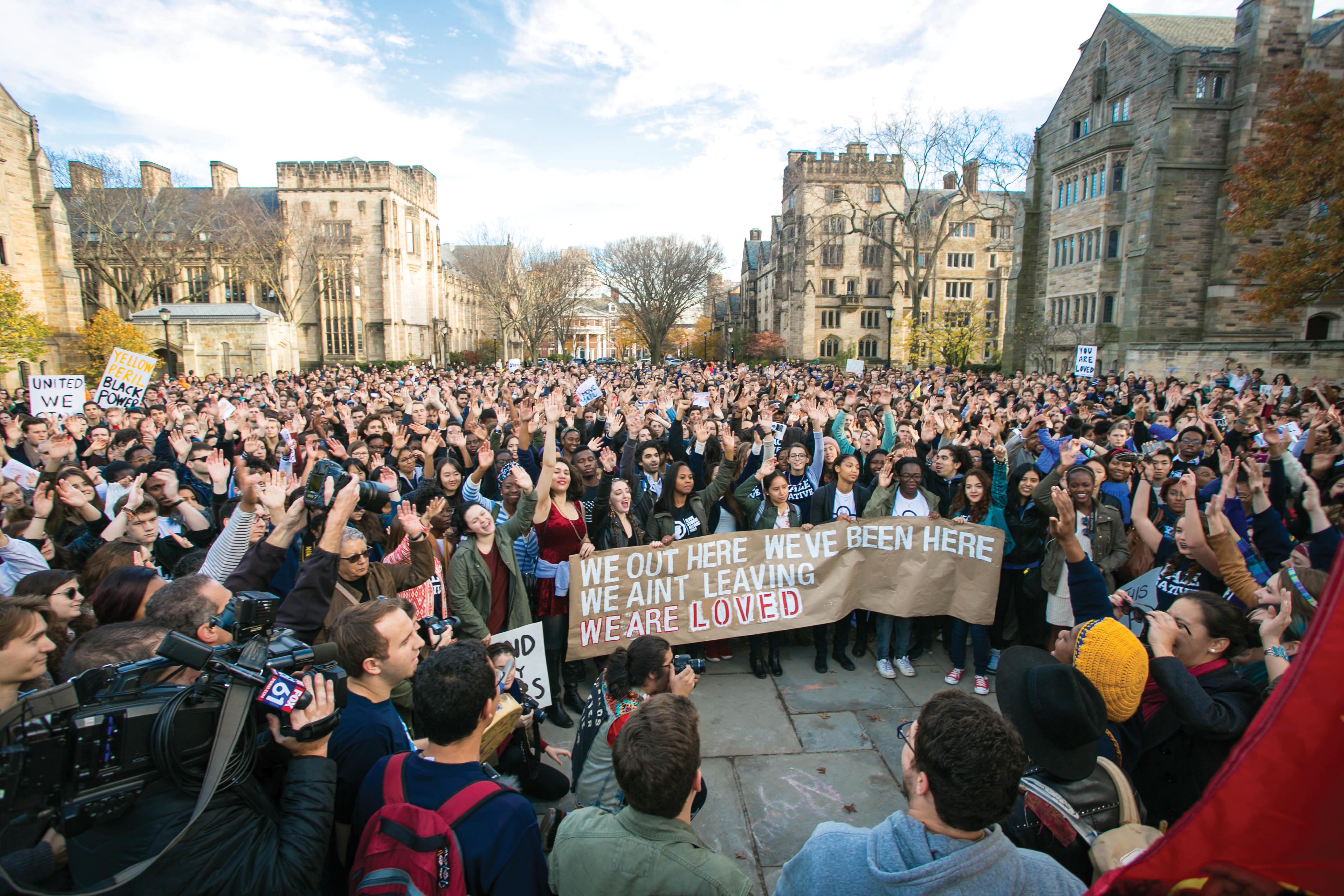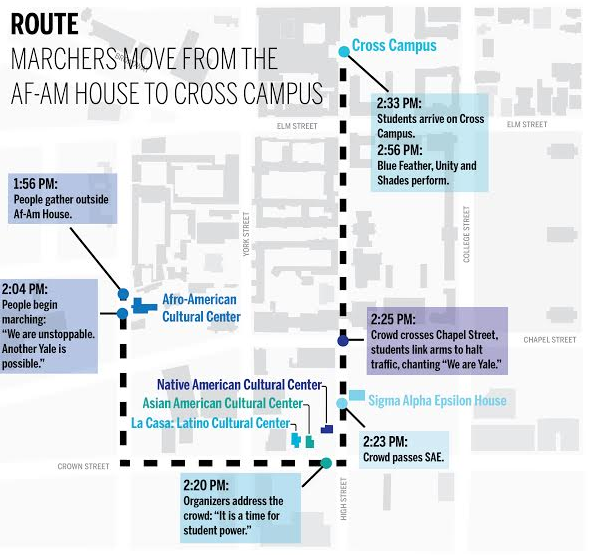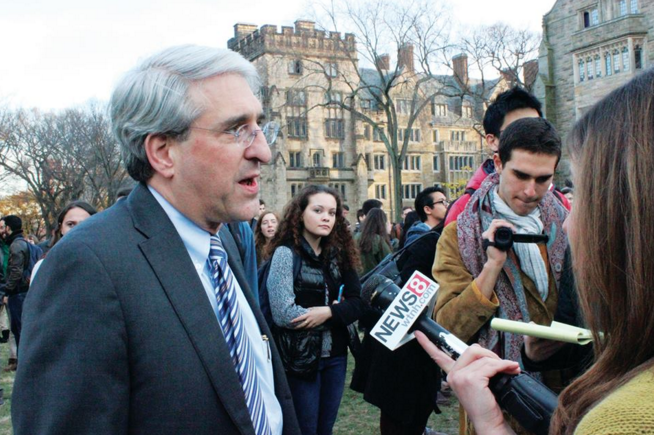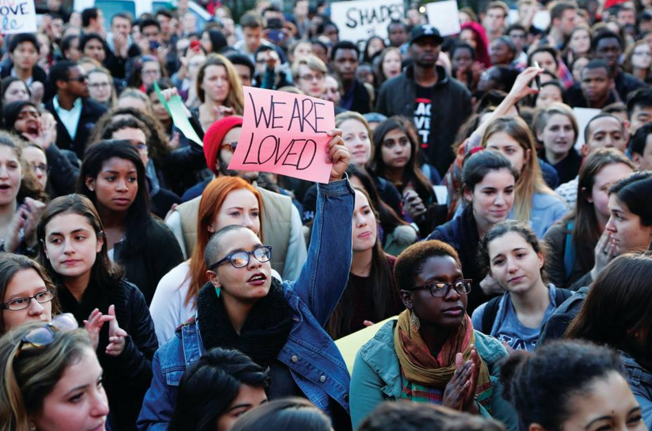
With the multicolored messages from last Thursday’s chalking event still visible on the pavement, students and supporters gathered once again on Cross Campus yesterday to stand in solidarity after a week of impassioned discussions about race at Yale.
But student organizers and participants said Monday’s March of Resilience — in which hundreds marched from the Afro-American Cultural Center to Cross Campus — had a markedly different tone from the tense confrontation with Yale College Dean Jonathan Holloway that took place at the same location last week. Student leaders at the event, which eventually attracted over 1,000 students, faculty and administrators, gave speeches about student power, solidarity and unity. The event also featured musical and cultural performances. Ultimately, the gathering transformed into an impromptu dance party on Cross Campus, which students said allowed them to join together as a community to turn the tide of campus conversation.
The march began at 2 p.m., with participants parading past the Native American Cultural Center, the Asian American Cultural Center and La Casa Cultural, as well as Sigma Alpha Epsilon — the site of an Oct. 30 party where a brother allegedly told a female student of color that entrance was for “white girls only.” More and more people joined the march as it progressed, with students linking hands at the intersection of High and Chapel Streets to stop traffic and make way for the procession. “We out here, we’ve been here, we ain’t leaving, we are loved,” they chanted as they walked. The march culminated on Cross Campus, where a sea of supporters assembled to listen, cheer, sing and dance.
“The point of this march was to shift the tone in the dialogue. Last week there was a lot of pain, and it was emotionally draining and traumatic for many people of color on campus, even though it was a necessary move,” said Alejandra Padin-Dujon ’18, a member of La Casa and the Af-Am House. “Right now, moving forward, we are looking to heal ourselves so that we can strengthen ourselves, regroup and push for specific demands and positive change for the future.”
Members of the Yale community found out about the March of Resilience — a joint effort among the four cultural centers — the day before through individual cultural centers, extracurricular panlists and word of mouth. Students were asked not to promote the event through social media until the day of the protest, in order to avoid the possibility of a counterprotest.
On Cross Campus, Lex Barlowe ’17, standing with a group of other student leaders above the crowd, led attendees in a song from an ethnic studies protest at the University of California, Berkeley that took place in 1999. Afterwards, the audience cheered and clapped as the Blue Feather Drum Group, Yale’s first American Indian performance group, began to drum and sing. Unity, a Korean percussion and dance troupe, as well as Shades, an a cappella group founded to sing music of the African Diaspora and the African-American tradition, also performed. Shades sang a medley of “Amen” and “We Shall Overcome,” the latter of which served as the anthem for the civil rights movement in the 1960s. Individual student leaders also spoke through megaphones, reflecting on the past week’s developments and calling on the crowd to take action.
“You are powerful. Look around you — we are powerful,” Ivetty Estepan ’18, one of the event organizers and a student coordinator for La Casa, told the crowd. “We are not victims; today, we are on our way to being victors.”
Estepan noted the news that University of Missouri’s president had stepped down yesterday amid student protests that he did not take seriously incidents of racism at the university. She said minority students have fought at Yale to create the cultural centers and to make changes in them.
Also present on Cross Campus during part of the rally was University President Peter Salovey, who engaged in discussions with students and interviews with media outlets.
“Last week was a reminder that we need to work harder, and this [march] is reinforcement that if we work harder, I think we can create an educational environment where everyone is respected, everyone is heard,” Salovey told the News. “I’m inspired to create that kind of Yale.”
Organizers said the march was a way to gather the diverse members on campus in a public demonstration of solidarity.
“The march was organized to emphasize our empowerment and show support and unity among different groups and cultural centers,” La Casa member Cathleen Calderon ’17 said. “Everyone is healing at different stages, so this is really about coming together and empowering each other. People really needed a dance party.”
The demonstration attracted a wide range of attendees, from members of the cultural centers and undergraduates to graduate students, professors and administrators, including the masters and deans of several residential colleges.
Gabby Cudjoe Wilkes DIV ’18 said that although she is not an undergraduate, she felt an emotional connection to the march because she is a woman of color. Cudjoe Wilkes took part in the march from its beginning at the Af-Am House, and she praised the students for their organization, which included teaching participants the chants ahead of time. Furthermore, she said, the tone of the rally was different from other events she has been involved with, since it focused more on improving the culture at Yale rather than saying that the students wanted to leave.
Njoya Tikum, a 2015 Yale World Fellow from Cameroon, said the demonstration showed that the current generation of students will be the ones to push society towards racial equality. He also commented on the diversity of the students participating in the march. Cudjoe Wilkes said the organizers made an effort to be inclusive of all cultural centers.
“What’s important is not their backgrounds, but that they share a common humanity,” Tikum said. He added that it was encouraging that so many Yale administrators were in attendance on Cross Campus.
Mary Lui, master of Timothy Dwight College and Yale’s first tenured Asian American studies professor, was also in attendance Monday.
“My job as an educator is to be here for the students,” she said. Trumbull College Master Margaret Clark also said it was critical for her to support students.
For many students, the march took priority over other obligations. A number of attendees interviewed said they had skipped class to attend the demonstration, citing a sense of responsibility that compelled them to be there in support of their peers.
Josh Tranen ’18 said he skipped his “Bible as Literature” course to attend the march, adding that he saw several other students in the class who were also there.
“I’m not going to go to Bible class and learn about the good things I should do for other people when I have this opportunity right here,” Tranen said. “I needed to be there to support my friends and students of color on this campus, and as a person who doesn’t have to undergo some of these experiences on a daily basis, it’s my job to show support to people who do.”
Hannah Schmitt ’18 also attended the demonstration, missing her “Introduction to Biological Anthropology” course to do so.
“This is an incredible space for students of color to express joy in the face of suffering, and I am amazed by their strength and honored that they are willing to share their voices so that all of us can learn,” Schmitt said.
Darwin Edwards ’19 also skipped class, stating that he was conflicted about the decision but eventually decided that it was more important to stand with students who are struggling.
Bailey Pickens DIV ’16, another attendee, praised the demonstration for its musical and light-hearted denouement.
“Every protest should end with a dance party,” Pickens said. “Because there’s real joy in doing what’s right.”










